Physical Address
304 North Cardinal St.
Dorchester Center, MA 02124
Surgery may be indicated for fractures that have recurrent or residual displacement after an attempt at reduction, especially if the fracture displacement results in disturbance in form or function of the hand.
Specific indications for surgery include rotational deformities, angular deformities, shortening, multiple fractures, and open fractures.
Even small amounts of rotational deformity (10 degrees; Fig. 14.1 ) can cause overlap (“scissoring”) of the digits; therefore this deformity must be corrected to preserve proper hand function.
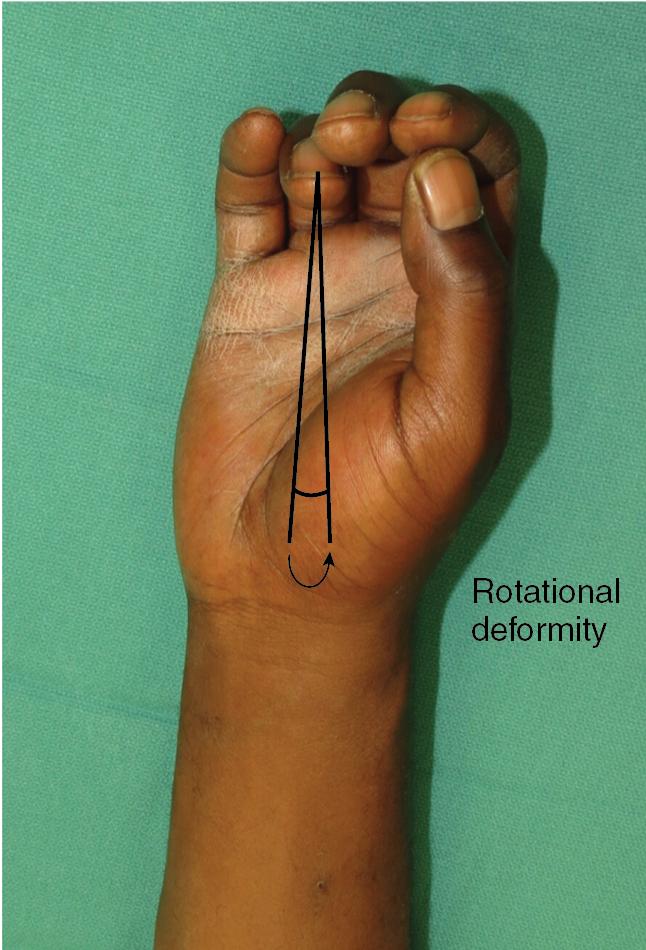
Angular deformity is typically apex-dorsal ( Fig. 14.2 ). Because of compensatory motion at the carpometacarpal (CMC) joints, residual angulation of metacarpal fractures is tolerated better in the thumb, ring, and small fingers than in the index and middle fingers.
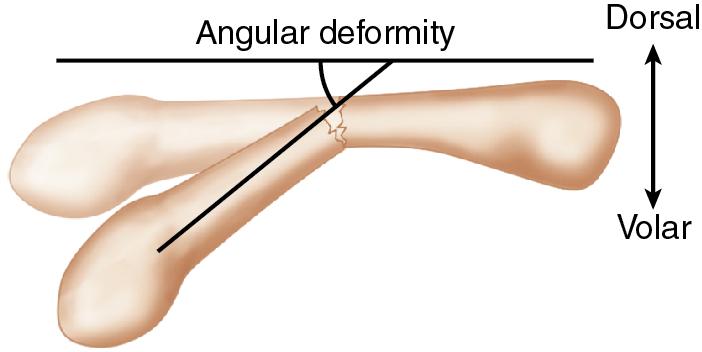
In particular, the small finger metacarpal neck fracture (often called a “boxer’s fracture”) is a common fracture that typically heals with negligible morbidity, despite significant residual angulation, as long as there is no rotational deformity.
Surgical correction should be considered for shaft angulation of:
Index and middle: More than 5 to 10 degrees
Ring: More than 20 degrees
Small: More than 30 degrees
Thumb: More than 30 degrees
Surgical correction should be considered for neck angulation of:
Index and middle: More than 10 to 15 degrees
Ring: More than 20 to 30 degrees
Small: More than 40 to 70 degrees (wide variation in recommendations)
Shortening is better tolerated than angular and rotational deformity, but loss of more than 5 mm of length may cause symptoms of pain, weakness, and a noticeable extension lag.
If adjacent metacarpals are injured, fracture instability is dramatically increased beyond what is seen for a single fracture, owing to loss of additional supporting structures.
Percutaneous Kirschner wire (K-wire) fixation may be preferable for open fractures with contamination or soft tissue defects requiring supplementary coverage to avoid exposure of hardware in an open wound.
Metacarpal neck fractures can also be treated with intramedullary fixation (see “Percutaneous Intramedullary Fixation of Metacarpal Head and Neck Fractures”).
Long oblique or spiral metacarpal shaft fractures may be more easily treated with lag screws (see “Open Reduction and Internal Fixation of Metacarpal Shaft Fractures”).
Note that most metacarpal fractures do not require operative treatment. Nondisplaced fractures or minimally displaced fractures without clinical deformity that meet acceptable radiographic parameters can be treated with a brief period of immobilization and early motion. Stable displaced fractures with satisfactory alignment after closed reduction can also be treated nonoperatively.
General contraindications for surgery:
Medically unfit: Highly comorbid patients or patients with active hemodynamic compromise or systemic infections should have medical issues addressed before considering operative treatment.
Patient preference: Low-demand patients can have satisfactory functional results even with substantial deformity and may prefer to be treated nonoperatively.
Specific contraindications for closed reduction and K-wire fixation include:
Comminution: K-wire fixation may not adequately maintain length and rotational stability in fractures with long comminuted segments, which can be better treated with bridge plating constructs (see Open Reduction and Internal Fixation of Metacarpal Shaft Fractures).
Bone loss: Fractures with segmental bone loss also require a lengthy and rotationally stable construct and can be better treated with bridge plating.
Early return to athletic activity: Exposed pins can migrate or cause infection and are not ideal for athletes seeking to return to early vigorous activity.
Noncompliance: Because of concerns for pin site infection, patients who will not reliably return for follow-up should be treated with other means.
Swelling and wounds on the dorsal surface should be noted. Swelling may obscure fracture displacement, and wounds may indicate the presence of an open fracture or associated soft tissue injury that may be prone to osteomyelitis if the bone is not debrided of contaminants ( Fig. 14.3A–B ).
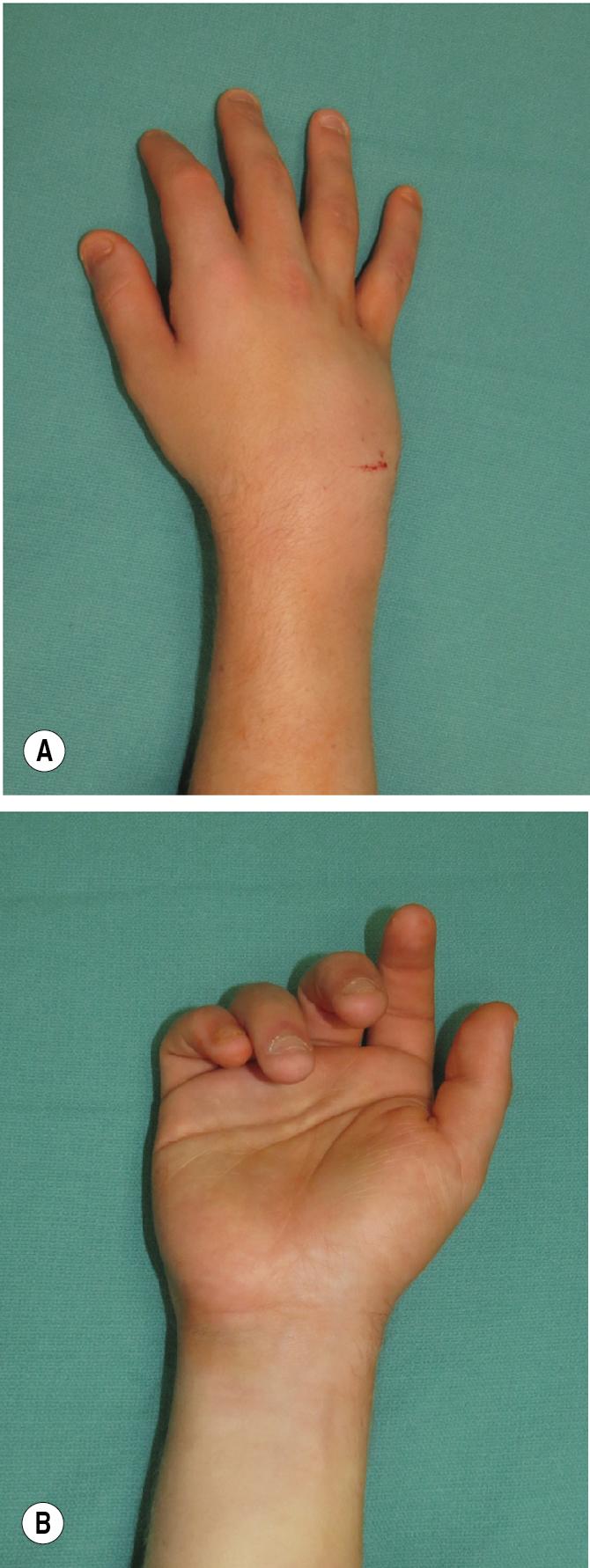
Malrotation can be assessed by simultaneously flexing the digits. Digits normally converge slightly and point toward the scaphoid tuberosity. Fig. 14.4 shows a ring finger that is not pointing toward the scaphoid tuberosity, labeled “S.”
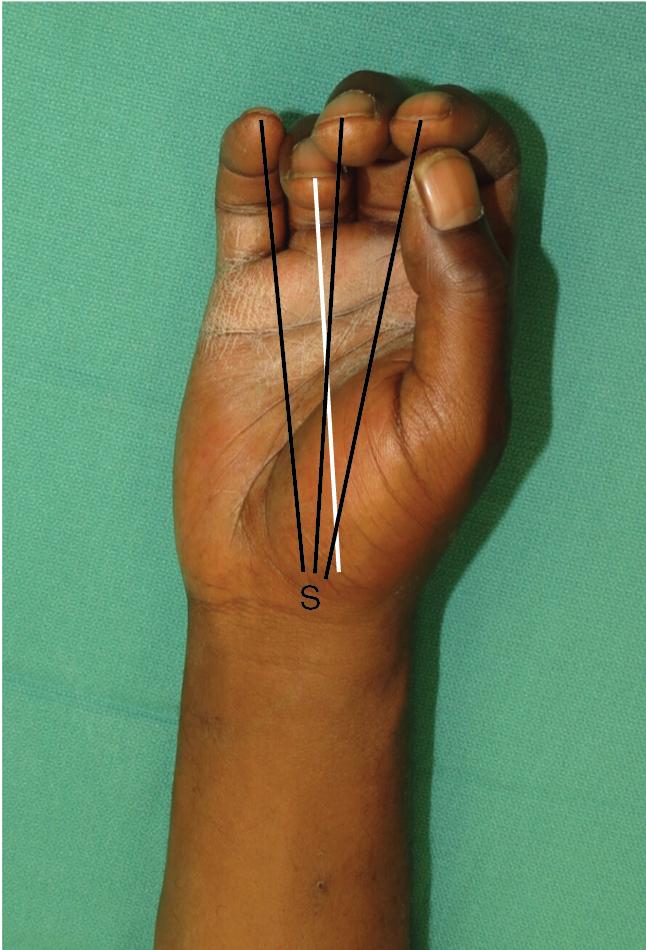
Subtle malrotation may be identified by close examination of the fingertips in mild flexion. Fig. 14.5 shows a ring finger that is pronated relative to the other digits.
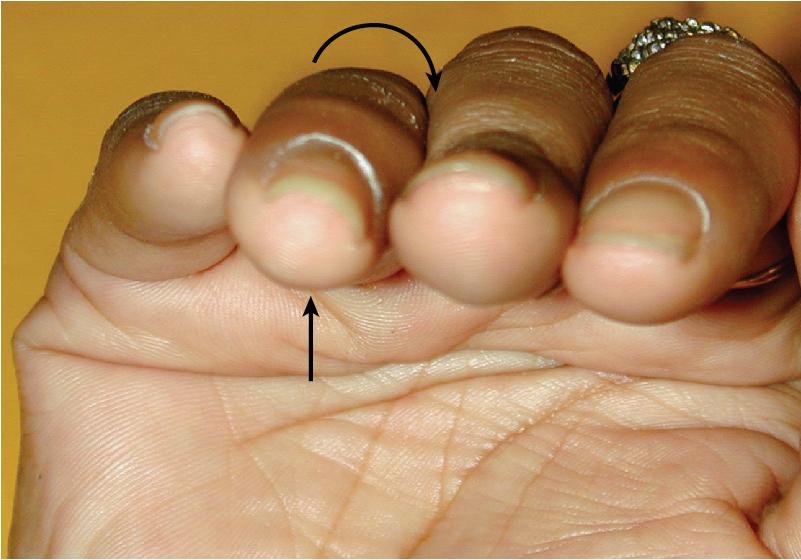
Limitations in range of motion should be identified, including any weakness, mechanical blocks, or extension lag. A mechanical block to motion may be present in juxta-articular fractures or be indicative of intra-articular extension. The presence of mild-to-moderate extension lag (20–30 degrees) at the metacarpophalangeal (MCP) joint is common but often improves over time.
Plain radiographs should be obtained in three views (posteroanterior [PA], oblique, and lateral; Fig. 14.6A–C ).
![FIGURE 14.6, (A) Posteroanterior [PA], (B) oblique, and (C) lateral radiograph of a second metacarpal fracture. FIGURE 14.6, (A) Posteroanterior [PA], (B) oblique, and (C) lateral radiograph of a second metacarpal fracture.](https://storage.googleapis.com/dl.dentistrykey.com/clinical/Techniquesandfixationofmetacarpalfractures/5_3s20B9780323794152001621.jpg)
PA view gives the best evaluation of shortening. Metacarpal heads of middle, ring, and small fingers are usually arranged in a line.
The lateral view provides the best evaluation of angulation.
Computed tomography (CT) may be useful in the evaluation of subtle or complex fracture patterns, or if intra-articular extension is suspected. CT is typically unnecessary for diaphyseal fractures.
Dorsal cutaneous nerves are at risk of injury or irritation, especially with wires placed near larger, more proximal nerve branches.
The metacarpal shaft is comprised of heavy cortical bone with a narrow medullary canal. In contrast, the cortical bone is thinner at the neck (metaphysis) of the metacarpal.
Of all the metacarpals, the ring finger is the narrowest, making it a challenging target for percutaneous fixation techniques.
Longitudinal traction, plus external pressure at the fracture site, can reduce most metacarpal shaft fractures, which typically have an apex-dorsal configuration.
The Jahss maneuver ( Fig. 14.7 ) can help with reduction of metacarpal neck fractures intraoperatively. This maneuver uses dorsally-directed force applied to the flexed proximal interphalangeal (PIP) joint to reduce an apex-dorsal metacarpal neck fracture. Alternatively, this maneuver can be performed with the PIP joint extended to relax the intrinsic muscles and further facilitate reduction.
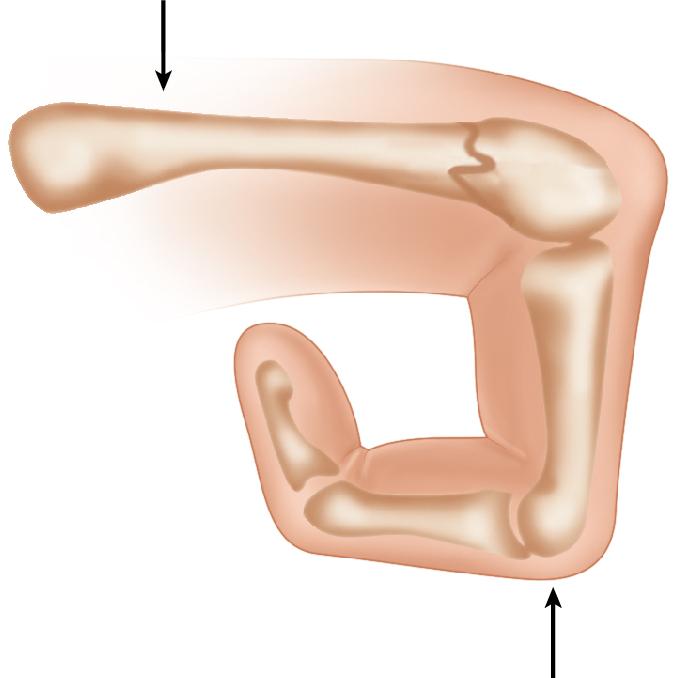
Subacute (partially healed) fractures may benefit from percutaneous manipulation with the tip of a K-wire or dental pick to loosen any early bony callus.
Rotational alignment needs to be assessed, corrected, and maintained during reduction and fixation. Holding the injured digit and neighboring digits in a composite fist can help maintain rotational alignment during this process.
Fixation is usually performed with 0.045-inch (1.1-mm) K-wires. Two configurations of wires can be used: longitudinal or transverse.
Longitudinal K-wires:
They are typically placed from distal to proximal ( Fig. 14.8A–D ).
![FIGURE 14.8, Postoperative (A) posteroanterior [PA], (B) oblique, (C) lateral radiographs, and (D) intraoperative fluoroscopic image demonstrating K-wire fixation of a fourth metacarpal fracture. FIGURE 14.8, Postoperative (A) posteroanterior [PA], (B) oblique, (C) lateral radiographs, and (D) intraoperative fluoroscopic image demonstrating K-wire fixation of a fourth metacarpal fracture.](https://storage.googleapis.com/dl.dentistrykey.com/clinical/Techniquesandfixationofmetacarpalfractures/7_3s20B9780323794152001621.jpg)
Wires may be left exposed distally or advanced to exit the skin proximally.
At least two wires are required for rotational stability.
Alternatively, a single longitudinal wire can be used to prevent angular displacement, and postoperative buddy-straps can be used to control rotational displacement in stable fracture patterns.
Transverse K-wires:
They are typically placed from index-to-middle or small-to-ring metacarpals ( Fig. 14.9 ).
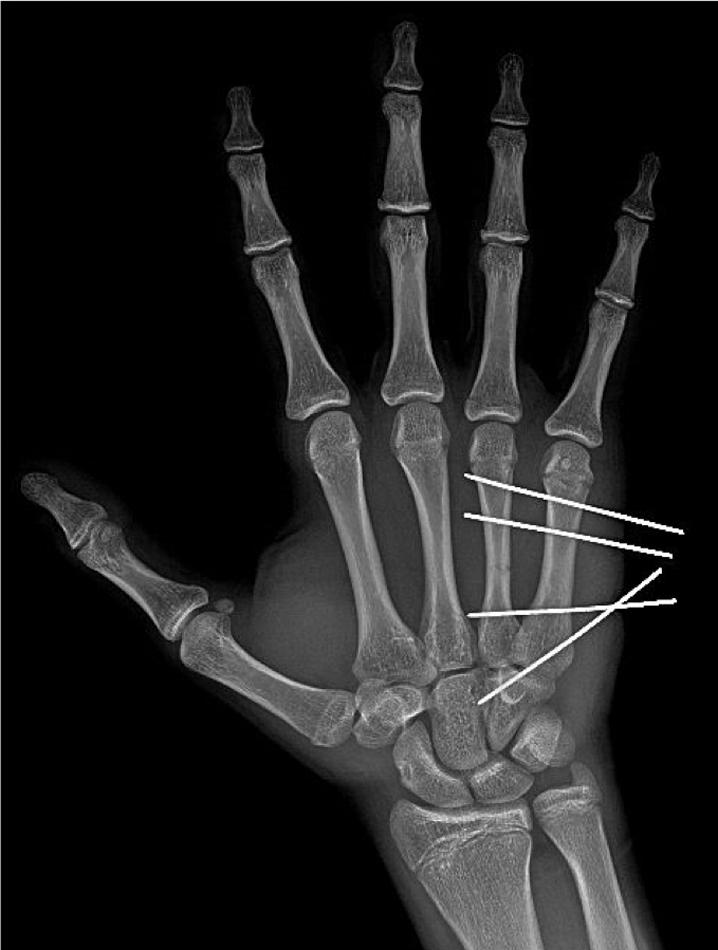
Uses a healthy neighboring metacarpal as a stable foundation to immobilize the adjacent fracture indirectly.
Longitudinal K-wires:
Wires can be placed extra-articular to the metacarpophalangeal (MCP) joint if the entry point is at the collateral ligament recess (metacarpal head/neck).
Consider mini-open techniques with limited dissection in some cases to avoid damage to cutaneous nerves and/or extensor tendons.
Longitudinal K-wires
Wires placed through the head of the metacarpal will transfix the extensor mechanism and often lead to extensor tendon adhesions. These tendon adhesions can typically be managed with postoperative therapy but may occasionally require reoperation.
Transverse K-wires
At least two K-wires are needed in the distal fragment to avoid palmar rotation of the distal fragment.
Fractures reduced indirectly can shorten over time. This K-wire configuration is best suited for length-stable fracture patterns (i.e., transverse or short oblique patterns with minimal translation at the fracture site).
K-wires are cut to an appropriate length to accommodate a pin cap (a protective covering for the end of the wire).
Alternatively, K-wires can be cut beneath the surface of the skin and removed with a minor procedure at a later date (not common).
A protective splint is applied, with ample padding around the K-wire exit sites. This initial splint is typically a forearm-based intrinsic-plus splint for the operative digit and at least one neighboring digit.
Strategies to prevent inadvertent K-wire migration into the hand:
Place a bend in the wire a few millimeters above the level of the skin. The wire should be far enough from the skin surface so that postoperative swelling will not cause impingement.
During insertion, position the K-wires so that the distal tip is abutted against cortical bone—either the cortex of the metacarpal base or the shaft on the opposite side of the fracture line. This will prevent inward migration of K-wires.
Padding and dressings should be designed to minimize skin tension and motion at pin sites. The repetitive pistoning of skin around pin entry points contributes to the introduction of bacteria at these sites.
Become a Clinical Tree membership for Full access and enjoy Unlimited articles
If you are a member. Log in here